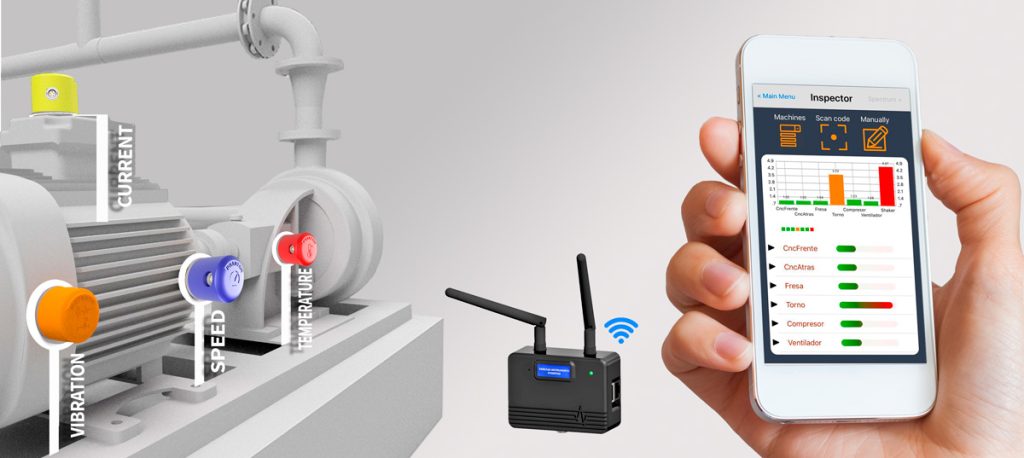The Unseen Guardians: Why Triaxial Vibration and Temperature Sensors are Essential for Industrial Health
Imagine being able to “listen” to your machinery and know exactly when it’s about to fail—long before any visible signs appear. This isn’t science fiction; it’s the reality of modern industrial maintenance, and it’s made possible by advanced sensors. While many sensors can measure a single parameter, the triaxial vibration and temperature measurement sensor is a powerhouse of data, providing a holistic view of a machine’s health.
This blog post will dive into what these sensors are, how they work, and why they are revolutionizing the way we approach industrial operations.

What is a Triaxial Vibration and Temperature Measurement Sensor?
At its core, this sensor is a sophisticated diagnostic tool in a single, compact package. It combines two critical functions:
- Triaxial Vibration Measurement: It measures vibrations along three independent, perpendicular axes: X, Y, and Z.
- Temperature Measurement: It simultaneously measures the temperature of the surface it’s mounted on.
The magic lies in this combination. Vibration data can reveal mechanical imbalances, misalignments, and loose parts, while temperature can indicate overheating, excessive friction, or a separate thermal issue. By capturing both sets of data at once, the sensor provides a comprehensive and accurate health profile of the equipment it’s monitoring.
How Does This All-in-One Sensor Work?
The sensor contains two primary sensing elements:
- For Vibration: Most commonly, a piezoelectric accelerometer is used. This component contains a tiny crystal that generates a voltage when it’s subjected to physical stress from vibration. Since the sensor has a triaxial design, it contains three of these accelerometers, each aligned to a different axis (X, Y, and Z), allowing it to capture the complete 3D motion of the machine.
- For Temperature: A thermistor or RTD (Resistance Temperature Detector) is typically used. The principle here is simple: as the temperature of the sensor changes, the electrical resistance of the thermistor or RTD changes in a predictable way. By measuring this resistance, the sensor can accurately report the temperature.
These two streams of data are then processed by the sensor’s internal electronics and transmitted to a data acquisition system. This can be done wirelessly via protocols like Bluetooth or Wi-Fi, or through a wired connection, providing real-time insights into the machine’s condition.
Why is Triaxial Measurement So Important?
Think of it this way: a single-axis sensor is like trying to diagnose a patient’s pain by only checking their heart rate. You might miss a broken bone or a separate infection. Similarly, a single-axis vibration sensor may only capture motion in one direction, potentially missing a critical failure signature that manifests in another.
Consider a simple electric motor. A misaligned shaft might cause significant vibration in the radial (X and Y) directions but not the axial (Z) direction. An unbalanced fan blade, however, might cause a different vibrational pattern. With triaxial data, you get a full 3D “fingerprint” of the machine’s motion, allowing for precise fault identification. It’s the difference between a vague symptom and a clear diagnosis.
Key Applications and Benefits
Triaxial vibration and temperature sensors are the cornerstone of predictive maintenance across various industries:
- Manufacturing: Monitoring the health of CNC machines, pumps, industrial fans, and motors to prevent costly unplanned downtime.
- Oil & Gas: Ensuring the reliability of critical assets like compressors and turbines in remote or harsh environments.
- Renewable Energy: Detecting early signs of failure in wind turbine gearboxes, which are expensive and difficult to repair.
- HVAC Systems: Identifying issues in large-scale air conditioning units and pumps before they fail and disrupt operations.
The benefits of implementing these sensors are significant and directly impact a company’s bottom line:
- Early Fault Detection: The primary advantage. By analyzing the data, you can predict failures and schedule repairs before a catastrophic breakdown occurs.
- Reduced Unscheduled Downtime: Instead of reacting to failures, you can plan maintenance activities, minimizing disruption to production.
- Extended Equipment Lifespan: Proactive maintenance and timely repairs prevent minor issues from becoming major ones, extending the life of your valuable assets.
- Improved Safety: Preventing machine failures reduces the risk of accidents and ensures a safer working environment for employees.
The Future is Smart and Proactive
The days of run-to-failure maintenance are rapidly fading. The integration of triaxial vibration and temperature sensors into an industrial IoT (Internet of Things) network empowers companies to transition from reactive to proactive and even prescriptive maintenance. These sensors are not just tools; they are the “eyes and ears” of the smart factory, providing the crucial data needed to make informed decisions.
By embracing this technology, businesses can optimize their operations, save millions in repair costs, and build a more reliable and resilient future.
